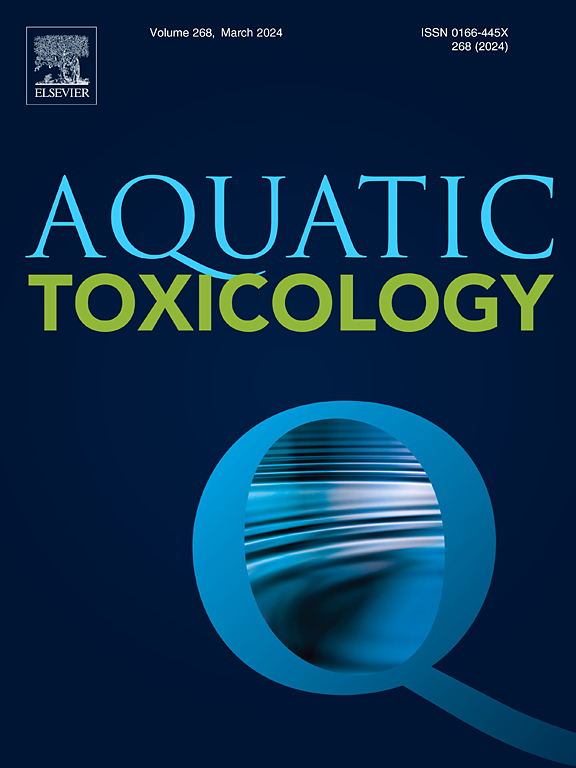亚致死性幼年二恶英(TCDD)暴露改变成年雄性斑马鱼的精子活力和全身卵黄原蛋白参数(Danio rerio)
IF 4.3
2区 环境科学与生态学
Q1 MARINE & FRESHWATER BIOLOGY
引用次数: 0
摘要
2,3,7,8-四氯二苯并-对二恶英(TCDD)是一种持久性有机污染物(POP),对人类、啮齿动物和鱼类具有明显的发育和生殖毒性。我们之前确定斑马鱼的亚致死幼年暴露(50万亿分之一;受精后3周和7周)导致跨代男性介导的不孕。在这里,我们使用相同的暴露模式来研究精子活力和全身类固醇和甲状腺激素水平对不育的潜在影响。在从发育暴露的鱼类中收集的渐进式精子中,速度测量(VCL, VSL, VAP)显着降低,而剩余的运动学参数(LIN, STR, WOB, ALH和BCF)未受影响。时间分析超过四个十秒的间隔揭示了不同的运动在暴露的精子。暴露鱼的渐进精子在早期(1)和晚期(4)时间点的所有三个速度指标都显著降低,而运动学参数LIN, STR和WOB仅在最终时间点(4)降低。与运动结果相对应,精子结构基因在精子细胞群中下调。暴露的成年男性全身匀浆中卵黄原蛋白显著增加,而皮质醇、11-酮睾酮(11-KT)、睾酮、三碘甲状腺原氨酸(T3)和甲状腺素(T4)水平未受影响。虽然TCDD暴露对鱼类的不利生殖后果已经得到了很好的研究,但我们的研究是第一个使用CASA(计算机辅助精子分析)来表征TCDD暴露对鱼类的影响。初始暴露10个月后,雄鱼卵黄原蛋白诱导和进行性精子运动的缺陷突出了这些发育暴露的鱼的内分泌和生殖失调的持久性,并对污染环境中的敏感人群产生了影响。本文章由计算机程序翻译,如有差异,请以英文原文为准。
Sublethal juvenile dioxin (TCDD) exposure alters sperm motility and whole-body vitellogenin parameters in adult male zebrafish (Danio rerio)
2,3,7,8-Tetrachlorodibenzo-p-dioxin (TCDD) is a persistent organic pollutant (POP) known for pronounced developmental and reproductive toxicity in humans, rodents, and fish. We previously determined that sublethal juvenile exposure in zebrafish (50 parts per trillion; 3- and 7-weeks post fertilization) resulted in transgenerational male-mediated infertility. Here, we used the same exposure paradigm to investigate potential effects on sperm motility and whole-body steroid and thyroid hormone levels contributing to infertility. In progressive sperm collected from developmentally exposed fish, velocity measures (VCL, VSL, VAP) were significantly decreased, while remaining kinematic parameters (LIN, STR, WOB, ALH, and BCF) were unaffected. Temporal analysis over four ten-second intervals revealed differential kinematics in exposed sperm. All three velocity metrics at both early (1) and late (4) timepoints were significantly decreased in progressive sperm of exposed fish, while kinematic parameters LIN, STR, and WOB were decreased at the final timepoint (4) only. Corresponding with motility outcomes, sperm structural genes were downregulated in spermatozoa cell clusters. Vitellogenin was significantly increased in whole-body homogenates of exposed adult males, while cortisol, 11-ketotestosterone (11-KT), testosterone, triiodothyronine (T3), and thyroxine (T4) levels were unaffected. While adverse reproductive outcomes of TCDD exposure are well-studied in fish, ours is the first to use CASA (computer-aided sperm analysis) to characterize impacts of TCDD exposure in fish. Vitellogenin induction and deficits in progressive sperm motility in male fish over 10 months after the initial exposure highlight the persistence of endocrine and reproductive dysregulation in these developmentally exposed fish, with concerning implications for sensitive populations in contaminated environments.
求助全文
通过发布文献求助,成功后即可免费获取论文全文。
去求助
来源期刊

Aquatic Toxicology
环境科学-毒理学
CiteScore
7.10
自引率
4.40%
发文量
250
审稿时长
56 days
期刊介绍:
Aquatic Toxicology publishes significant contributions that increase the understanding of the impact of harmful substances (including natural and synthetic chemicals) on aquatic organisms and ecosystems.
Aquatic Toxicology considers both laboratory and field studies with a focus on marine/ freshwater environments. We strive to attract high quality original scientific papers, critical reviews and expert opinion papers in the following areas: Effects of harmful substances on molecular, cellular, sub-organismal, organismal, population, community, and ecosystem level; Toxic Mechanisms; Genetic disturbances, transgenerational effects, behavioral and adaptive responses; Impacts of harmful substances on structure, function of and services provided by aquatic ecosystems; Mixture toxicity assessment; Statistical approaches to predict exposure to and hazards of contaminants
The journal also considers manuscripts in other areas, such as the development of innovative concepts, approaches, and methodologies, which promote the wider application of toxicological datasets to the protection of aquatic environments and inform ecological risk assessments and decision making by relevant authorities.
 求助内容:
求助内容: 应助结果提醒方式:
应助结果提醒方式:


